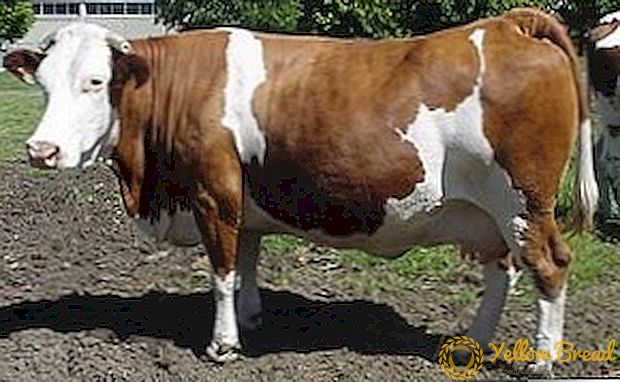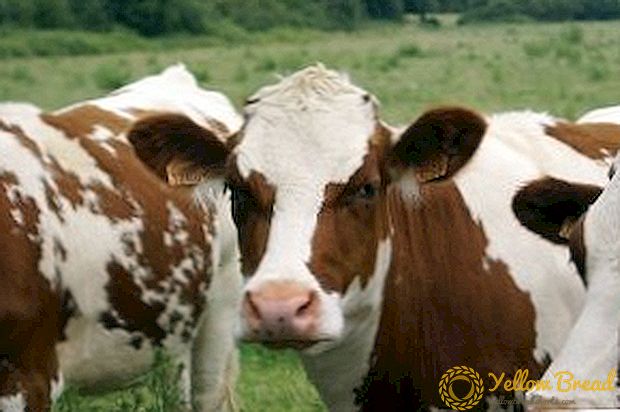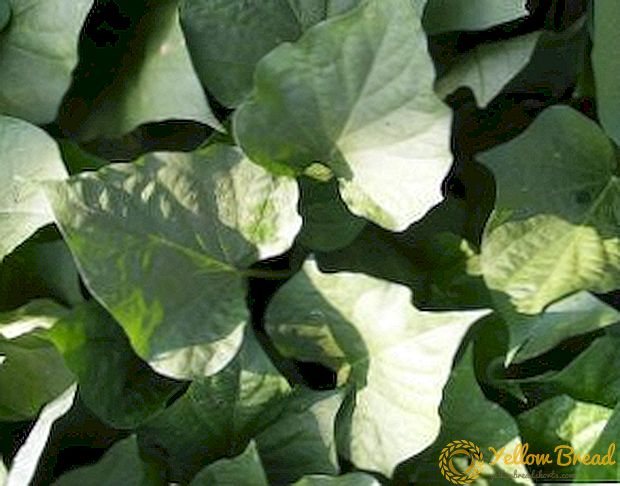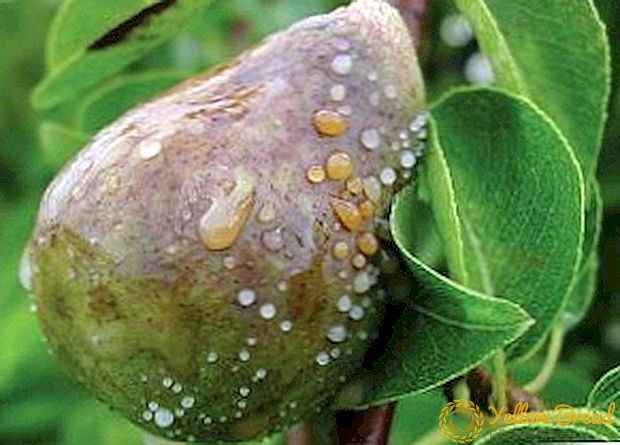 Among the diversity of livestock industries leading cattle. This industry brings in half of all revenues from livestock. Dairy products, meat, and light industry material are obtained from these animals. Beef and veal meat go in second place after pork. Milk contains easily digestible substances necessary for people and animals.
Among the diversity of livestock industries leading cattle. This industry brings in half of all revenues from livestock. Dairy products, meat, and light industry material are obtained from these animals. Beef and veal meat go in second place after pork. Milk contains easily digestible substances necessary for people and animals.
And from high-quality leather they make shoes, clothes and many other products. Buttons, combs and other items are made from by-products such as horns and hooves. Even large cattle are used as traction force in agriculture. Today we will tell about Simmental breed.
- What is interesting you can learn about Simmental breed?
- What is the udder of Simmental cows?
- What are the advantages of the Simmental breed?
- What breed defects do you need to pay attention to when buying it?
- What is the milk and meat productivity of the Simmental breed?
What is interesting you can learn about Simmental breed?
 Simmental cattle is a representative breed of meat and dairy type. The origin of this breed is Switzerland.Of all the cattle in this country, 60 percent are from this breed.
Simmental cattle is a representative breed of meat and dairy type. The origin of this breed is Switzerland.Of all the cattle in this country, 60 percent are from this breed.
This breed is one of the oldest breeds. It was created by crossing the breeds with meat, dairy and labor productivity. The formation of this breed was promoted by both economic factors and natural-historical ones.
In our countries, the Simmental breed was brought in the second half of the past century.
The color of the horns is yellowish, and the tips are brownish in color. In Switzerland, it is believed that if the tips of the horns are black, then the cow is not purebred.
The constitution of Simmental cattle is strong, and in some cases even rough.
Feature of the breed is a large and rough head. The frontal part is also quite developed, the horns are also quite developed.
The neck of the cows of medium length and thickness, but in the bulls of the Simmental breed, the neck is very fleshy and short. The withers are wide enough, while in bulls it is sometimes split.
 Animals have a deep, wide, long and large chest coverage. In animals that are not properly raised, there may be interception behind the shoulder blades.
Animals have a deep, wide, long and large chest coverage. In animals that are not properly raised, there may be interception behind the shoulder blades.
The animals are tall, straight, medium length, broad and muscular croup.
The tail is high enough.
The legs of the Simmental breed are not long, the bones and joints are well developed. On the hind legs, you can notice a defect (the angle between the ankle and the metatarsus is very large, this is also called the “ivory leg”), and the front legs are turned outwards. Animals have strong, light and well-developed hooves.
Cow skin is elastic and heavy; its weight is between 10 and 14 percent. Large oxen and oxen have very valuable leather.
Generally, Simmental breed differs from others in its growth, coarse bones and large breasts. Animals have well-developed muscles, thick skin and well-set limbs.
The Simmental breed is well developed, its average measurements are as follows:
- The mass of newborn calves is 34-42 kilograms, at the age of one and a half years their weight reaches 340 kilograms.
- The weight of an adult heifer ranges from 650 to 850 kilograms, fattened cows can be more weight.
- The mass of an adult bull is such that from 750 to 1100 kilograms, and bulls, which are well fed, can reach 1300 kilograms.
- The height of one bull at the withers is 138-145 centimeters, and the cows are 133-135 centimeters.
- The length of the body of animals on average 158 -162 centimeters.
- The circumference of the metacarpus varies from 18.5 to 20 centimeters.
What is the udder of Simmental cows?
 The milk productivity of Simmental cows is average.
The milk productivity of Simmental cows is average.
Udder and milk wreaths are not as developed as those of the milky type.
The mammary glands of cows are somewhat rude. Rear lobes developed slightly worse than the front.
It also happens that the udder of cows can be overgrown with thick hair.
The average milk productivity per year varies from 2,500 to 5,500 kilograms, its fat content is from 3.8 to 4.1 percent.
An integral indicator in the productivity of cows is such a thing as an udder index. The concept of this stands for the ratio of the total amount of milk to the yield of the two front udder shares.From this you can find out how well all the shares of the udder are developed and understand the productivity of the cow. In the breed we are describing, the index is 42-45 percent. That speaks about quite good dairy efficiency.
What are the advantages of the Simmental breed?
There are many advantages of keeping Simmental breed in agriculture, but we will tell about the main ones:
- Since the Simmental breed belongs to the meat and dairy type, it can be understood that the meat and milk are of good quality.
- When feeding young stock, you can get a big weight gain, which exceeds the performance of shorthorns and herefords. But if we compare the edible and inedible parts of these breeds, then the last two edible parts have more.
- The biological positive characteristic of this breed is its precocity.
- Rapid acclimatization to different conditions is also a positive characteristic.
- Simmental brute is in good health and capable of performing heavy work.
- When breeding breed along lines or along cross lines, Simmentals are considered to be an important way of improvement in breeding plants and breeding farms.
- The high value of the skin of these animals refers to a positive factor.
- Equally important is the obedience and intelligibility of animals.
- The positive side of this breed is its mobility and vigor.
- Animals of the described breed are resistant to diseases.
What breed defects do you need to pay attention to when buying it?
 Simmental breed is very demanding on its diet. Hay fed them must be of high quality.
Simmental breed is very demanding on its diet. Hay fed them must be of high quality.- Also, the breed is demanding for its content, it needs care. If this is not followed, the breed quickly degenerates.
- The disadvantage of the breed can be improper setting limbs.
- A flaw in the animal's constitution is sagging of the back.
- Another disadvantage of this breed is the weak development of the front udder shares of cows.
- Udder hair overgrowth is not a good indicator.
What is the milk and meat productivity of the Simmental breed?
 Meat production rates are very good due to the ability of rapid feeding. High-quality meat, tasty enough, not too fat, muscle fibers are not deep-fibrous, but still the weight of the bones is greater than the weight of the meat.The fat content in meat is about 17 percent.
Meat production rates are very good due to the ability of rapid feeding. High-quality meat, tasty enough, not too fat, muscle fibers are not deep-fibrous, but still the weight of the bones is greater than the weight of the meat.The fat content in meat is about 17 percent.
Average milk indicators vary in the range from 2500 to 5500 kilograms of milk, and its fat content reaches 4.1 percent.
High milk yield is obtained in the homeland of animals, and is 15898 kilograms of milk. Also, high yields are obtained in Hungary. The largest milk yield was obtained from the Dame burenka and is 19,665 kilograms of milk per year of lactation. The highest milk yield per day from this cow was 70.1 kilograms of milk.
In purebred simmentals, milk production is quite good. Average values range from 3200 to 3500 kilograms of milk, and its fat content is from 3.7 to 4.1 percent. The best purebred cows give from 8,200 to 10,900 kilograms of milk with fat content from 4.05 to 4.87 percent. The record holder is Zozulya’s cow with a milk yield of 12,760 kilograms.
In some farms, a very high weight gain of young Simmental breed was obtained. For example, in the Voronezh region, the Heir 2 bull weight gain was one and a half kilograms per day. Under normal conditions, gobies do not need weight gain. It should be noted that the high milk yield and high rates of concentrates cause the deposition of fat in the body, which is not very good effect on sexual function.And with a high yield, calves eat less roughage, which is the basis for the formation of animals in the meat direction.
 Due to the vigor of the young, this breed needs mineral and protein feed. Growing such food should be at high rates of milk, concentrates, root vegetables and good hay.
Due to the vigor of the young, this breed needs mineral and protein feed. Growing such food should be at high rates of milk, concentrates, root vegetables and good hay.
From other European countries, the Simmental breed is very common in Austria. In recent years, this breed develops in the meat direction, but dairy indicators do not disregard. According to the counts that are carried out on Simmental cattle, the average productivity of one cow was 3,823 kilograms, and the fat content of milk was 4.06 percent.
The society that breeds this breed set itself the task of getting about 4,500 kilograms of milk with a fat content of 4.1 percent. Also, breeders set themselves the task of improving the precocity and meat productivity of the breed.
In 1958, fifteen bulls of this breed were brought from Austria to the Soviet Union, from whose mothers from 5000 to 5176 milk were obtained, with fat content of 4.2 to 4.37 percent. And brought bulls were used in the breeding factories of Ukraine to refresh the blood of Simmentals, who were bred in the country at that time.
Simmental bulls have a lethal yield of 65 percent, while cows have 53-56 percent. Simmental breed when crossed can improve meat performance in non-meat breeds. In mixed breeds, slaughter yield was up to 63 percent.

 Simmental breed is very demanding on its diet. Hay fed them must be of high quality.
Simmental breed is very demanding on its diet. Hay fed them must be of high quality.




